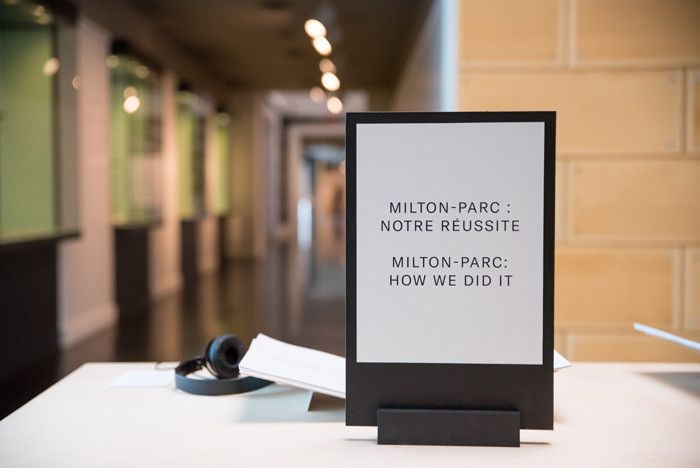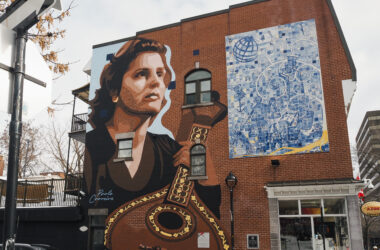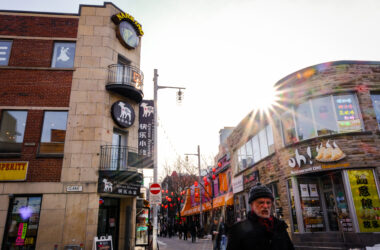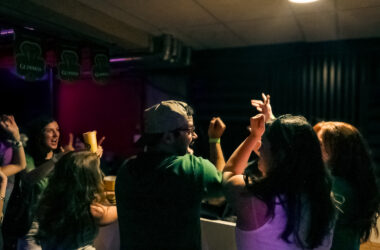Fifty years ago, real estate developers Concordia Estates Ltd. purchased the majority of the historic buildings that make up the Milton-Parc neighbourhood with the intention of clearing them out to make way for new shopping, hotel, and apartment developments. Angered by this encroachment, a group of local activists protested the construction, claiming it would destroy the character of the community and leave long-time residents without homes. The Canadian Centre for Architecture’s exhibition, “Milton-Parc: How we did it” runs until Feb. 17 and spotlights the neighbourhood’s rich history. On Sept. 27, a panel also titled “Milton-Parc: How we did it” featuring the movement’s organizers accompanied the display.
The Milton-Parc neighbourhood, known by students as the ‘McGill ghetto,’ spans six square blocks, bounded by Hutchison, Ste. Famille, Milton, and Pine Ave. Dimitri Roussopoulos, a curator and the first speaker at the Sept. 27 event, emphasized activism in the neighbourhood as an example of citizen involvement. He also participated in the planning stages of the Milton-Parc protests.
Roussopoulos’ presentation centred around the Committee’s landmark demonstration in May 1972, which protested Concordia Estates Ltd.’s plan to build high-rise, high-rent housing in the neighbourhood. Students can recognize LaCité, the first step in this project of urban ‘renewal’ and the only part of the plan that was actually completed, as the antithesis to the charming, low-rise feel of its surrounding area. Addressing the audience, Roussopoulos paid homage to the historic protest while rallying the audience around the Committee’s ongoing advocacy.
“Milton-Parc is on a land trust, and it is radical [in itself] to have a land trust,” Roussopoulos said. “[It is] contrary to market capitalism […] that [to this day] there is no buying and selling of property in the six block radius. […] We won, and we’re still fighting.”
Activists took to the microphone to recount their roles in the movement. Among them was Henry Milner, who was one of the first to be arrested after the 1972 demonstration. Milner recounted that, during the protest, activists occupied the Concordia Estates Ltd. offices and were jailed for ‘public mischief,’ before the charges were dropped. Milner emphasized the Milton-Parc protest as a catalyst for municipal change movements across Montreal: The ‘70s activism in Milton-Parc was, as many of the speakers point out, part of an international movement.
“[The activism in Milton-Parc] represented the idea of thinking globally and acting locally,” Milner said. “Our generation had a mission to keep neighbourhoods going.”
The accompanying photography exposition reflected a sense of reverence for the activism of years past in a slideshow of black-and-white images of protests and the neighbourhood’s history. McGill alumni Clara Gutsche and David Miller took photos of the Milton-Parc community for the Citizens’ Committee, which served as background entertainment during the event. These photographs, many of which are also displayed in the hallway cases, both kept visual records of the movement and showed the neighbourhood’s charm in contrast with the stark, modernist aesthetic of the proposed new developments.
This year, on the 35th anniversary of Communauté Milton-Parc (CMP) and the 50th anniversary of the Milton-Parc Citizens’ Committee (MPCC), the legacy of this historic neighbourhood and the activists who fought to preserve it are more important than ever. Still devoted to preserving the community, MPCC seeks to take possession of the defunct Hôtel-Dieu Hospital for social housing, community, and cultural spaces. Alanna Dow, current president of CMP, also mentioned that the community was looking at vacant parking lots as possible co-ops for aging Milton-Parc residents. In an interview with The McGill Tribune, Roussopoulos again emphasized that through this work, the group continues to preserve Milton-Parc’s unique character.
“The Milton-Parc project is a six-block downtown land trust on which there are 22 nonprofit housing co-ops and 1500 people in residence,” Roussopoulos said. “All land is owned in common. It is a significant piece of real estate [with a significant history.] […] It is the largest housing project in North America, and not enough Montrealers know this. […] This kind of community project should be replicated in other parts of Montreal.”









